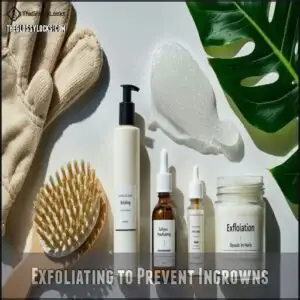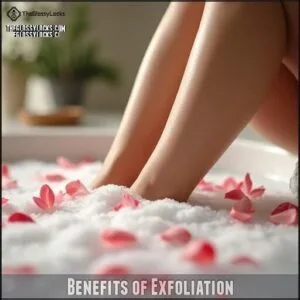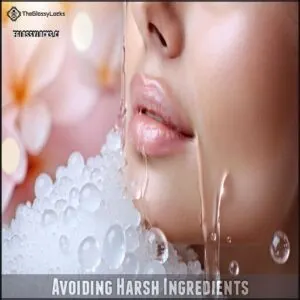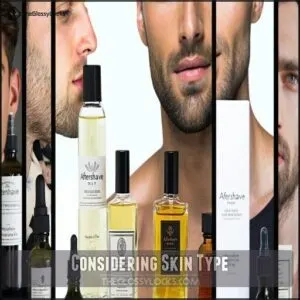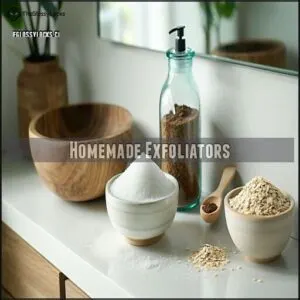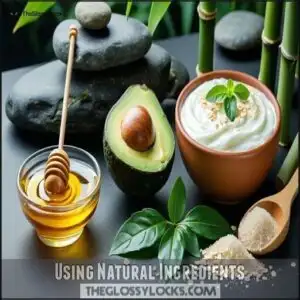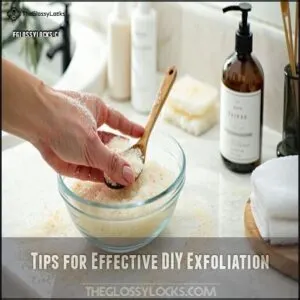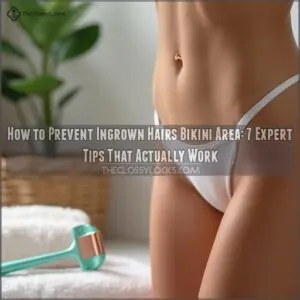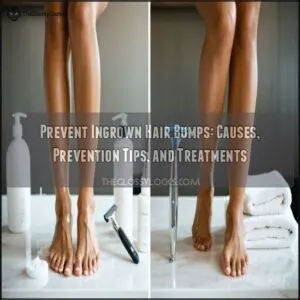This site is supported by our readers. We may earn a commission, at no cost to you, if you purchase through links.
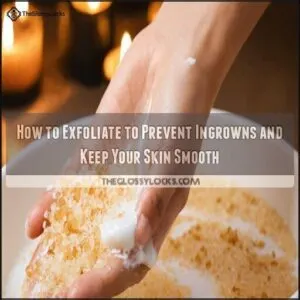
Gently scrub your skin 2-3 times a week to remove dead skin cells that trap hair. Use a washcloth, exfoliating brush, or a scrub with fine grains—like sugar or oatmeal—and stick with warm water, not scalding hot (your skin will thank you!).
Circular motions work best, and don’t press too hard—this isn’t a wrestling match with your face.
Exfoliating keeps hair follicles clear and helps hair grow the right way. Pair this with a good moisturizer to avoid dryness, and you’re well on your way to smooth, bump-free skin.
Bonus? It feels amazing!
Table Of Contents
- Key Takeaways
- What Are Ingrown Hairs
- Exfoliating to Prevent Ingrowns
- Benefits of Exfoliation
- Choosing The Right Exfoliator
- DIY Exfoliation Techniques
- Preventing Ingrowns With Consistent Exfoliation
- Frequently Asked Questions (FAQs)
- Do chemical exfoliators help with ingrown hairs?
- How to get rid of an ingrown toenail?
- What is the best exfoliator for ingrown hairs?
- What is the easiest way to prevent ingrown hairs?
- How to remove an ingrown hair?
- Can a sugar scrub treat ingrown hairs?
- How to exfoliate to prevent ingrown hairs?
- How do you stop ingrown hairs from forming?
- What is the best way to exfoliate your pubic area?
- What naturally draws out an ingrown hair?
- Conclusion
Key Takeaways
- Exfoliate 2-3 times a week with gentle, circular motions to remove dead skin cells and clear clogged pores.
- Use products with ingredients like salicylic or glycolic acid for effective chemical exfoliation that prevents ingrown hairs.
- Always moisturize after exfoliating to hydrate your skin and reduce irritation.
- Shave with the grain, avoid dry shaving, and keep your skin smooth by combining exfoliation with a consistent hair removal routine.
What Are Ingrown Hairs
Ingrown hairs happen when a hair grows back into your skin instead of rising outward, often causing red bumps and discomfort.
When hair curls back into the skin, it brings irritation, red bumps, and discomfort—stay ahead with smart skincare habits!
They’re more common in areas you shave or wax, but anyone can deal with them, especially if you’ve got curly or coarse hair.
Causes of Ingrown Hairs
Ingrown hairs happen when hair grows back into the skin instead of out.
Curly or coarse hair from a curved hair follicle is more prone to this.
Shaving methods often create sharp edges, increasing risk.
Pore clogging traps hair, blocking growth.
Sometimes skin healing too fast causes hair obstruction, looping back under.
Genetic factors also influence susceptibility.
Regular care helps prevent these troubles.
It is essential to understand that ingrown hairs can be managed with proper care, and genetic factors play a significant role in susceptibility.
Symptoms of Ingrown Hairs
Your skin might start acting funny with these telltale signs.
- Redness and Itching: An annoying combo that screams irritation.
- Pain and Bumps: Tender spots often resemble tiny pimples.
- Skin Inflammation: That area may swell or feel warm.
- Hyperpigmentation: Dark marks can linger like unwanted gifts from persistent ingrown hairs.
These symptoms are gentle reminders to care for your skin.
Common Areas Affected by Ingrown Hairs
You’re most likely to spot ingrown hairs in areas you shave or wax often—like bikini lines, underarms, legs, face, or even the scalp.
These spots see more irritation, making hair sneak back into the skin.
Check out this quick guide:
| Area | Risk Level | Prevention Tip |
|---|---|---|
| Bikini Line | High | Use bikini line exfoliation. |
| Underarms | High | Shave sparingly, moisturize. |
| Legs | Medium | Try gentle leg exfoliation. |
| Face | Medium | Use shaving cream consistently. |
| Scalp | Low | Avoid clogged follicles. |
Reorganizing your shaving and waxing routine can help prevent ingrown hairs, especially in high-risk areas like the underarms and bikini line, by following the prevention tips provided.
Exfoliating to Prevent Ingrowns
Getting rid of ingrown hairs starts with good exfoliation habits. By gently scrubbing away dead skin cells, you’re clearing the path for hair to grow outward instead of curling back in. It’s like helping your skin breathe again, giving trapped hairs an exit strategy.
Good exfoliation clears the way for smooth, healthy skin, giving trapped hairs a chance to grow out naturally and stress-free.
To prevent ingrown hairs, here are simple exfoliation techniques:
- Choose the right tools: Use exfoliating brushes, gloves, or scrubs designed for your skin type.
- Stick to a schedule: Exfoliation frequency matters—2-3 times a week is often enough for most, but adjust based on skin sensitivity.
- Use the best exfoliators: Look for products with salicylic or glycolic acid to gently remove buildup.
Wrap things up with proper post-exfoliation care like moisturizing to soothe and hydrate.
Benefits of Exfoliation
When you exfoliate, you remove dead skin cells and clear clogged pores, which helps your hair grow out smoothly instead of curling back into the skin.
It also reduces irritation and keeps your skin soft, making ingrown hairs less of a hassle.
Removing Dead Skin Cells
Removing dead skin cells through skin exfoliation boosts cell turnover and promotes skin renewal.
Regular exfoliation techniques improve circulation, leaving your skin healthier and glowing. Plus, it helps product absorption, so your moisturizers work better.
Keeping up with exfoliation frequency also loosens trapped hairs, making ingrown hair exfoliation more effective. It’s an easy way to prevent ingrown hairs and smooth things out, which is a great benefit of regular exfoliation.
Unclogging Pores
Clearing your pores is like giving your hair follicles room to breathe. Effective exfoliation prevents clogged pores caused by oil buildup and dead cells.
This reduces ingrown hairs while improving product penetration and skin texture.
- Use exfoliants with salicylic acid to deep clean pores.
- Stay consistent with exfoliation frequency, 2-3 times weekly.
- Focus on areas prone to buildup.
- Avoid harsh scrubbing brushes to ensure gentle exfoliation.
Promoting Healthy Hair Growth
Exfoliating promotes healthy hair growth by unclogging pores and keeping hair follicles open. Think of it as uncluttering a crowded room—your hair gets space to grow freely.
When follicles are clean, they absorb nutrients better, strengthening hair over time. Plus, smoother skin means fewer snags during the growth cycle.
Regular scalp exfoliation helps maintain overall scalp health, preventing dryness and irritation.
Here’s a quick guide:
| Benefit | Impact | How It Helps |
|---|---|---|
| Follicle Health | Reduced clogging | Encourages natural growth |
| Hair Strength | Better nutrient flow | Prevents weak strands |
| Hydration Impact | Softer skin texture | Aids in easy growth |
Reducing Inflammation
Right after encouraging hair to grow healthily, you’ll want to settle the skin and calm any irritation.
Exfoliating helps reduce inflammation, making your skin happy again.
Try:
- Soothing ingredients like aloe vera cut down redness quickly.
- Anti-inflammatory agents, such as chamomile, aid in skin calming.
- Post-exfoliation care with gentle moisturizers prevents irritation.
Your skin will thank you later!
Choosing The Right Exfoliator
Finding the right exfoliator can make all the difference in keeping your skin smooth and free from ingrowns.
Look for products with gentle ingredients that suit your skin type, and skip anything too harsh that might cause irritation.
Ingredients to Look For
Ingredients can change the game for exfoliation and ingrown hair prevention. Look for stars like salicylic acid (a beta-hydroxy acid), glycolic acid, and lactic acid, all champions of chemical exfoliation.
Add soothing agents like aloe or tea tree oil for anti-inflammatories that calm irritation. These smooth cell turnover while keeping skin hydrated and hairs growing freely instead of curving back.
Consider using a salicylic acid exfoliant for the best results.
| Ingredient | Type | Benefit | Skin Type | Example Product |
|---|---|---|---|---|
| Salicylic Acid | BHA | Unclogs pores | Oily/Acne-prone | PFB Vanish + Chromabright |
| Glycolic Acid | AHA | Removes dead skin cells | Normal/Dry | Glytone Exfoliating Lotion |
| Lactic Acid | AHA | Gentle exfoliation | Sensitive | Gillette’s Lactic Acid Serum |
| Tea Tree Oil | Natural | Antibacterial & soothing | All | Tea Tree Oil Serum |
| Aloe Vera | Natural | Calms inflammation | All | Aloe Vera Gel with Vitamin E |
Avoiding Harsh Ingredients
When choosing exfoliators, avoid harsh ingredients that can irritate sensitive skin.
Skip scrubs with sharp particles or irregular grains—no need for your skin to battle a sandstorm! Instead, go gentle with these tips:
- Avoid nut shells or large sugar grains.
- Look for chemical exfoliants like AHAs/BHAs.
- Skip over-scrubbing.
- Research product ingredients carefully.
- Always patch-test first.
To further reduce irritation, consider fragrance-free skincare options and remember to patch-test first, and opt for a gentle approach to exfoliation.
Considering Skin Type
Not all skin types need the same exfoliation.
Sensitive skin benefits from gentle exfoliation to avoid irritation.
Oily skin loves products that control excess oil while unclogging pores.
Dry skin craves hydration; choose mild, non-stripping exfoliators.
Combination skin requires a balanced approach. Normal skin can handle most options, but watch for overlooked sensitivities.
Listen to your skin—it always knows best!
DIY Exfoliation Techniques
You don’t need fancy products to keep your skin smooth and prevent ingrown hairs.
With a few natural ingredients and simple steps, you can easily make effective exfoliators at home.
Homemade Exfoliators
A homemade scrub is an easy way to exfoliate and prevent ingrowns.
Sugar scrubs are a gentle favorite, while salt scrubs offer a coarser option for tougher skin.
Coffee grounds boost circulation and soften skin, and oil infusions add hydration to DIY mixtures.
For those interested, you can even find pre-made sugar scrub options online.
Try oatmeal masks for a soothing touch, or mix sugar and oil for simple, effective exfoliation with a homemade scrub.
Using Natural Ingredients
Natural ingredients make DIY exfoliation easy and effective.
Try these ideas:
- Mix a honey sugar scrub for gentle exfoliation and hydration.
- Use sugar exfoliation with oil for a moisturizing homemade scrub.
- Rely on herbal remedies like green tea for soothing benefits.
- Experiment with natural scrubs, combining oatmeal and yogurt for soft, radiant skin.
Many find that a natural skincare routine is more gentle, and using natural ingredients can lead to better results with a consistent skincare routine.
Tips for Effective DIY Exfoliation
For effective DIY exfoliation, gently apply your homemade scrub, like a sugar scrub, in circular motions.
Focus on rough spots, but don’t overdo it to protect skin sensitivity.
Mix natural ingredients carefully, matching your skin care preferences, and choose soft tools like gloves or sponges for tool selection.
Always follow with post-exfoliation care—moisturize for smooth, healthy skin!
Preventing Ingrowns With Consistent Exfoliation
When you exfoliate regularly, you clear away dead skin and unclog pores, giving hair the space it needs to grow properly.
This simple habit helps prevent ingrown hairs and keeps your skin feeling smooth and healthy.
Creating an Exfoliation Routine
Creating an exfoliation routine doesn’t have to feel like a chore.
Timing matters, so aim to exfoliate 2-3 times weekly, adjusting based on skin sensitivity.
Evaluating results helps you tweak as needed, and stick to gentle product application: no need to scrub like you’re cleaning tile grout!
Stay consistent to prevent ingrown hairs and keep your skin care routine effective.
Combining Exfoliation With Other Hair Removal Methods
Pairing exfoliation with hair removal is like setting the stage for success. Shaving exfoliation clears dead skin, letting the razor glide easily and helping prevent shaving ingrown hairs.
Waxing exfoliation guarantees smoother pulls, while laser exfoliation benefits from open follicles. Even tweezing exfoliation reduces irritation.
Targeting shaving ingrowns requires proper exfoliation techniques. Always exfoliate gently before and after to keep your skin smooth and ingrown-free, which is key to achieving ingrown-free skin.
Maintaining Healthy Skin and Hair Follicles
By focusing on healthy skin habits, you’ll prevent ingrown hairs and keep those hair follicles happy.
Try this:
- Hydrate daily to support barrier function and Skin Hydration.
- Use Gentle Cleansing products to avoid irritation.
- Boost Circulation with light massage or exercise.
- Feed your skin with nutrient-rich oils for Follicle Nutrition.
Consistency is your golden ticket to smooth skin!
Frequently Asked Questions (FAQs)
Do chemical exfoliators help with ingrown hairs?
Think of chemical exfoliators as your detective, uncovering hidden culprits like dead skin and oil.
By dissolving buildup, they keep hair follicles clear, letting hairs grow outward instead of curling in, preventing those annoying ingrown bumps.
How to get rid of an ingrown toenail?
Soak your foot in warm, soapy water for 15-20 minutes to soften the nail.
Gently lift the edge with sanitized tweezers and place cotton underneath.
Avoid tight shoes, and see a doctor if infection develops!
What is the best exfoliator for ingrown hairs?
Your skin’s future is calling!
The best exfoliator for ingrown hairs combines chemical exfoliants like salicylic or glycolic acid with soothing agents like aloe.
They unclog pores, lift trapped hairs, and keep your skin smooth.
What is the easiest way to prevent ingrown hairs?
To prevent ingrown hairs, always use a sharp razor with shaving cream, shave in the hair’s growth direction.
Avoid dry shaving, and keep your skin hydrated to reduce irritation.
Exfoliate regularly.
How to remove an ingrown hair?
An ingrown hair’s like an uninvited guest overstaying its welcome.
Apply a warm compress, gently exfoliate with circular motions, and avoid picking.
If it’s stubborn, consult a dermatologist for safe removal and healing.
Can a sugar scrub treat ingrown hairs?
A sugar scrub gently exfoliates, removing dead skin cells and unclogging pores to free trapped hairs.
It’s a simple, sweet fix for ingrown hairs—just massage it in circles and rinse for smoother, happier skin.
How to exfoliate to prevent ingrown hairs?
Think of exfoliation as clearing a path for healthy hair growth.
Gently scrub using a chemical or physical exfoliant 2-3 times weekly, focusing on prone areas.
This removes dead skin, keeping follicles open and ingrowns at bay, which is crucial for healthy hair growth.
How do you stop ingrown hairs from forming?
Keep your skin smooth by exfoliating a few times a week, always shave with the grain, and moisturize daily.
Use sharp razors, avoid dry shaving, and consider gentler hair removal methods to reduce ingrown hair risk.
What is the best way to exfoliate your pubic area?
Treat your pubic area like a delicate garden.
Gently exfoliate with a soft washcloth or chemical exfoliant like salicylic acid. Move in light circles, avoiding pressure.
Hydrate afterward to keep skin silky and irritation-free.
What naturally draws out an ingrown hair?
A warm compress softens your skin and hairs, helping draw out an ingrown.
Gently exfoliate with a washcloth in circular motions to lift the hair.
Avoid digging it out—it’s not a treasure hunt!
Conclusion
Smooth, stay consistent, and stick with exfoliation—your skin will thank you.
Learning how to exfoliate to prevent ingrowns isn’t complicated but requires commitment. By sloughing off dead cells, you’re clearing the path for healthy hair growth while minimizing irritation.
Pair regular exfoliation with a hydrating moisturizer, and you’ll avoid dryness and bumps. Whether you use a store-bought scrub or a natural DIY mix, the key is gentle care.
Healthy, happy skin starts with mindful maintenance.
- https://www.aad.org/public/kids/hair/how-hair-grows
- https://www.mayoclinic.org/diseases-conditions/ingrown-hair/symptoms-causes/syc-20373893
- https://my.clevelandclinic.org/health/articles/11031-hair-removing-unwanted-hair
- https://highpointmedspa.com/skin-care-clinic.shtml
- https://www.thezoereport.com/p/glycolic-acid-in-skin-care-is-the-answer-to-brighter-smoother-skin-45747304


